Related Research Articles
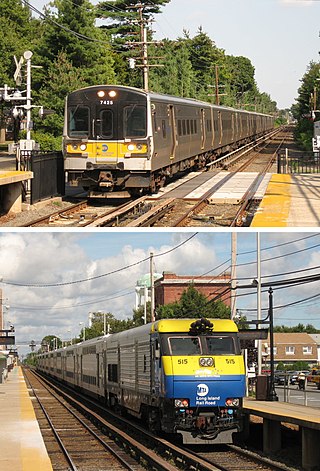
The Long Island Rail Road, often abbreviated as the LIRR, is a railroad in the southeastern part of the U.S. state of New York, stretching from Manhattan to the eastern tip of Suffolk County on Long Island. The railroad currently operates a public commuter rail service, with its freight operations contracted to the New York and Atlantic Railway. With an average weekday ridership of 354,800 passengers in 2016, it is the busiest commuter railroad in North America. It is also one of the world's few commuter systems that runs 24/7 year-round. It is publicly owned by the Metropolitan Transportation Authority, which refers to it as MTA Long Island Rail Road. In 2023, the system had a ridership of 75,186,900, or about 253,800 per weekday as of the fourth quarter of 2023.

The Flushing–Main Street station is the eastern terminal on the IRT Flushing Line of the New York City Subway, located at Main Street and Roosevelt Avenue in Downtown Flushing, Queens. It is served by the 7 local train at all times and the <7> express train during rush hours in the peak direction.

The Jamaica station is a major train station of the Long Island Rail Road located in Jamaica, Queens, New York City. With weekday ridership exceeding 200,000 passengers, it is the largest transit hub on Long Island, the fourth-busiest rail station in North America, and the second-busiest station that exclusively serves commuter traffic. It is the third-busiest rail hub in the New York area, behind Penn Station and Grand Central Terminal. Over 1,000 trains pass through each day, the fourth-most in the New York area behind Penn Station, Grand Central Terminal, and Secaucus Junction.
The Archer Avenue lines are two rapid transit lines of the New York City Subway, mostly running under Archer Avenue in the Jamaica neighborhood of Queens. The two lines are built on separate levels: trains from the IND Queens Boulevard Line serve the upper level, and trains from the BMT Jamaica Line serve the lower.

The Sutphin Boulevard–Archer Avenue–JFK Airport station is a two-level station on the IND and BMT Archer Avenue Lines of the New York City Subway. It is located at the intersection of Sutphin Boulevard and Archer Avenue in Jamaica, Queens. It is served by the E and J trains at all times, as well as the Z train during rush hours in the peak direction. This station has four tracks and two island platforms, with two platform levels: E trains stop on the upper level while J/Z trains stop on the lower level.
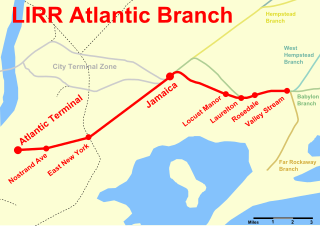
The Atlantic Branch is an electrified rail line owned and operated by the Long Island Rail Road in the U.S. state of New York. It is the only LIRR line with revenue passenger service in the borough of Brooklyn.

Locust Manor is a station on the Long Island Rail Road's Atlantic Branch in the Locust Manor neighborhood of Queens, New York City. The station is located at Farmers Boulevard and Bedell Street and is 14.0 miles (22.5 km) from Penn Station in Midtown Manhattan.

The Laurelton station is a station on the Long Island Rail Road's Atlantic Branch, in the Laurelton neighborhood of Queens, New York City. It is 14.9 miles (24.0 km) from Penn Station in Midtown Manhattan. The station is located at the intersection of 225th Street and 141st Road.
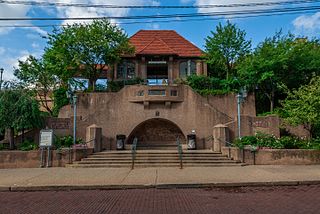
The Forest Hills station is a station on the Main Line of the Long Island Rail Road (LIRR), located in the Forest Hills neighborhood of Queens in New York City. It is lightly used compared to other stations in the city, with only 1,967 weekday riders; many residents opt for the subway because of its more frequent service, cheaper fares, and direct express trains to Midtown Manhattan. The station is wheelchair accessible.

The Montauk Branch is a rail line owned and operated by the Long Island Rail Road in the U.S. state of New York. The line runs the length of Long Island, 115 miles (185 km) from Long Island City to Montauk. However, in LIRR maps and schedules for public use, the term Montauk Branch refers to the line east of Babylon; service from Jamaica to Babylon is covered by separate Babylon Branch schedules, while the line west of Jamaica is currently unused for passenger service. A select number of Montauk Branch trains operate via the Main Line during peak hours.
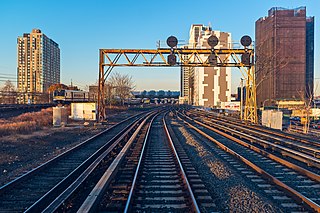
The Main Line is a rail line owned and operated by the Long Island Rail Road in the U.S. state of New York. It begins as a two-track line at Long Island City station in Long Island City, Queens, and runs along the middle of Long Island about 95 miles (153 km) to Greenport station in Greenport, Suffolk County. At Harold Interlocking approximately one mile east of Long Island City, the tracks from the East River Tunnels and 63rd Street Tunnel into Manhattan intersect with the Main Line, which most trains use rather than using the Long Island City station.
The Long Island Rail Road is a railroad owned by the Metropolitan Transportation Authority in the U.S. state of New York. It is the oldest United States railroad still operating under its original name and charter. It consolidated several other companies in the late 19th century. The Pennsylvania Railroad owned the Long Island Rail Road for the majority of the 20th century and sold it to the State in 1966.
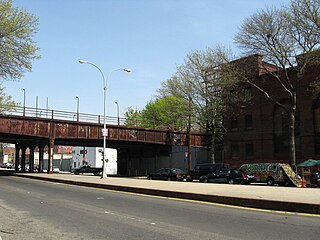
Woodhaven Junction was a station complex on the Atlantic Branch and Rockaway Beach Branch of the Long Island Rail Road, located at Atlantic Avenue between 98th and 100th Streets in Woodhaven, Queens, New York City. The elevated Rockaway Beach station was closed in 1962 along with the rest of the branch, while the underground Atlantic Branch station was closed and abandoned on January 7, 1977.
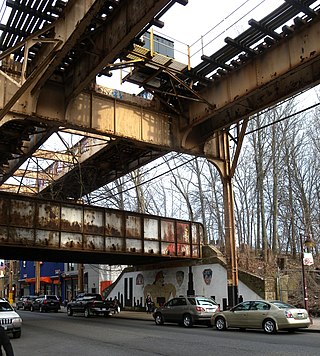
The Brooklyn Manor station was a station on the Long Island Rail Road's Rockaway Beach Branch located on the south side of Jamaica Avenue at 100th Street, straddling the border between Richmond Hill and Woodhaven in Queens, New York City. The station name referred to the nearby Brooklyn Manor section of Woodhaven, originally a 603-lot development bounded by Woodhaven Boulevard to the west, 96th/98th Streets to the east, Forest Park to the north, and Jamaica Avenue to the south. The station opened in January 1911, and was constructed as a replacement for the Brooklyn Hills station, which was located 3,000 feet (910 m) to the north. This station closed along with the rest of the Rockaway Beach Branch in 1962, and was subsequently demolished.

The Richmond Hill station is a closed station on the Montauk Branch of the Long Island Rail Road in the Richmond Hill neighborhood of Queens in New York City. The station is located at Myrtle Avenue and cuts diagonally from the intersection of Jamaica Avenue and Lefferts Boulevard through to Hillside Avenue. The station has two tracks and an island platform. Richmond Hill was the only station on the Lower Montauk Branch that was elevated with a high-level platform for passengers to wait for trains; the others were at ground level, with low-level platforms.
Central Railroad of Long Island was built on Long Island, New York, by Alexander Turney Stewart, who was also the founder of Garden City. The railroad was established in 1871, then merged with the Flushing and North Side Railroad in 1874 to form the Flushing, North Shore and Central Railroad. It was finally acquired by the Long Island Rail Road in 1876 and divided into separate branches. Despite its short existence, the CRRLI had a major impact on railroading and development on Long Island.
Springfield Gardens was an island platform station that existed along the Babylon-Montauk Branch of the Long Island Rail Road, in the Springfield Gardens, Queens section of Queens, New York City. The station was located between St. Albans and Rosedale Stations, north of Springfield Junction. The only visible evidence of the station today is a wide gap between the tracks.
Bellaire was a station stop along the Hempstead Branch of the Long Island Rail Road. The station was located between 211th Street and 212th Street between 99th Avenue and Jamaica Avenue in Bellaire, Queens.
Higbie Avenue was a railroad station along the Atlantic Branch of the Long Island Rail Road, in Queens, New York City. The station was located on 140th Avenue and Edgewood Avenue in the Springfield section of Queens, New York City between Locust Manor and Laurelton stations.
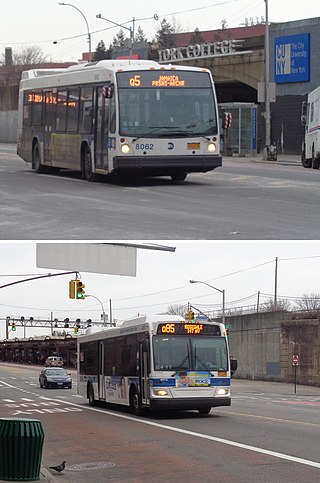
The Q5 and Q85 bus routes constitute a public transit corridor running along Merrick Boulevard in southeastern Queens, New York City. The routes run from the Jamaica Center transit hub and business district to Rosedale, with continued service to Green Acres Mall in Valley Stream, Nassau County. The Q4 and Q84 buses also serve the northern portion of the corridor, before diverging east along Linden Boulevard and 120th Avenue respectively. The Q4, Q5, and Q85 also provide limited-stop service along the corridor. The routes on the corridor mainly serve as feeder routes to New York City Subway services at Jamaica Center–Parsons/Archer station.
References
- ↑ Old Southern Road from Jamaica Station to Springfield Junction (Arrt's Arrchives)
- 1 2 David Keller; Steven Lynch (2005). Revisiting the Long Island Rail Road: 1925-1975. Arcadia Publishing. p. 20. ISBN 978-0-7385-3829-7.
- ↑ Atlantic Division and Main Line timetable
- ↑ O to Q Queens Street Name changes
- ↑ 81 to 120 Queens Street Name changes
- ↑ The Long Island Rail Road A Comprehensive History Part Six The Golden Age 1881 – 1900 Archived April 19, 2015, at the Wayback Machine
- ↑ "State Can't Operate LIRR: Transit Board". Newsday. November 16, 1949. Retrieved March 31, 2023.
- ↑ "RR Denies Plea to Close 3 Depots". Newsday. November 23, 1949. Retrieved March 31, 2023.
- ↑ "Fight Closing of 2 LI Depots". New York Daily News. November 28, 1949. Retrieved March 31, 2023.
- 1 2 "PSC Gets LIRR Plea to Give Up 2 Stations". New York Daily News. February 3, 1955. Retrieved March 31, 2023.
- ↑ "LIRR's Plea to Close Two Stations Fought". New York Daily News. February 6, 1955. Retrieved March 31, 2023.
- ↑ "Resume LIRR Station Drop Hearing May 4". New York Daily News. March 27, 1955. Retrieved March 31, 2023.
- ↑ "L.I. to Shut Station, Must Keep Another". The New York Times. July 23, 1955. ISSN 0362-4331 . Retrieved March 31, 2023.
- ↑ "LIRR Permitted to Shut Station". New York Daily News. July 23, 1955. Retrieved March 31, 2023.
- ↑ LIRR Station History (TrainsAreFun.com) Archived January 6, 2011, at the Wayback Machine